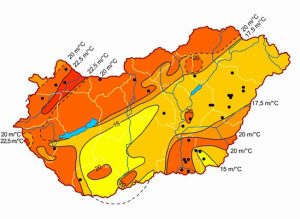What is a geothermal heat pump?
All liquid-to-water heat pumps are called geothermal heat pumps. In these great products, the temperature range is scaled as narrow as possible. It is equipped with a condenser that allows the production of heating water with the same temperature as the condensing temperature and the minimum hydraulic loss in the operating temperature range. A geothermal heat pump is a set of special heat pumps with high COP values designed in a given heat recovery mode and produced at a higher cost. Mi az a COP? What is a COP?The COP shows how much heat the device can deliver using 1kW of electricity.
What is a COP?
The COP shows how much heat the device can deliver using 1kW of electricity.
Based on the experience gained in the design and implementation of geothermal heat pump systems, today in Hungary, if someone mentions a heat pump system, the idea of saving energy and the possibility of reducing costs comes to mind. If we look at it from a different perspective, we realize that it is more than that. With this new technology, we protect our environment, we increase our comfort, and we increase security of supply.

Specificity of geothermal heat pumps
Designing heat pump systems for more capacity than necessary is very costly and unnecessary in terms of return on investment. Accurate planning is essential. Extreme capacity requirements are bridged in such cases by using a built-in electric heater or other auxiliary heater. Of course, this is understandable and acceptable, as it is the most advantageous solution in terms of price / value ratio (monoenergetic systems).
The peculiarity of geothermal heat pump systems is that the heat recovery side of the heat pump must be dimensioned depending on the soil conditions, the material and location of the probes, the annual kWh of energy to be removed from the ground and the from SCOP (seasonal COP) value, ie the probe number and should be determined in the depending on of data and expectations.
Today, even monovalent liquid-to-water heat pump systems can be designed with complete safety. It is possible to scale the probe system with so many reserves under the given soil conditions that the heating system can operate even in lower than average outside air temperature conditions.This is made possible not only by the sizing of the probe system, but also by the development of heat pump technology. The incorporation of state-of-the-art control and protection systems into the heat pumps prevents the probes from overcooling at colder-than-average outdoor temperatures.
State-of-the-art EVI (steam injection) circuit heat pumps can operate at significantly lower ground temperatures with the same COP values. Thus, much larger reserves are formed in the designed probe systems.
In the last 20 years, the population’s attitude towards energy has also undergone a significant change, in which the primary role was played by the drastic increase in energy prices, and climate change, which can be felt more and more in Hungary. Today, heat pump systems require state-of-the-art control equipment, remote access options to optimize their energy consumption.
At the same time, it can be stated that geothermal heat pump heating-cooling-DHW systems today are the safest and most efficient, and last but not least the most environmentally friendly solutions for air conditioning, heating and cooling energy supply of buildings, institutions, agricultural and in industrial facilities.
Another feature of these systems is that they can be well integrated with solar systems, with which the use of renewable energy can reach 80-90%, which is a significant contribution to reducing CO2 emissions and further reducing the burden on the environment.
With the development of energy storage, the design of island-mode systems makes it unnecessary to connect to large supply systems, which increases security of supply in our climate-rapidly changing world.

